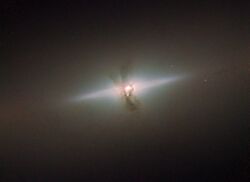Astronomy:NGC 4111
| NGC 4111 | |
|---|---|
 NGC 4111 by Hubble Space Telescope | |
| Observation data (J2000 epoch) | |
| Constellation | Canes Venatici |
| Right ascension | 12h 07m 03.1s[1] |
| Declination | 43° 03′ 57″[1] |
| Redshift | 792 ± 5 km/s[1] |
| Distance | 43 ± 13 Mly (13.1 ± 4.1 Mpc)[1] |
| Apparent magnitude (V) | 10.7 |
| Characteristics | |
| Type | SA(r)0+ [1] |
| Apparent size (V) | 4.6′ × 1.0′[1] |
| Other designations | |
| UGC 7103, MCG +07-25-026, PGC 38440[1] | |
NGC 4111 is a lenticular galaxy in the constellation Canes Venatici. It is located at a distance of circa 50 million light-years from Earth, which, given its apparent dimensions, means that NGC 4111 is about 55,000 light-years across. It was discovered by William Herschel in 1788. NGC 4111 possesses both thin and thick discs.[2]
Characteristics
The galaxy is characterised by a series of dusty filaments running through its centre. They are associated with a ring of material encircling the galaxy's core, which is not aligned with the galaxy's main disc, suggesting that this polar ring of gas and dust is actually the remains of a smaller galaxy.[3] The polar ring has a diameter of 450 pc and in it is embedded one with a diameter of 220 pc visible in H21-0 imaging. The estimated cold molecular gas mass within the polar ring is estimated to be 108 M☉. The ring can provide enough material for an active galactic nucleus and for circumnuclear star formation.[4] The galaxy also possesses an X-shaped, (peanut shell)-shaped bulge,[5] thought to arise from an unstable stellar bar. The stellar population within the disk is quite young (2 ±0.3 billion years mean age) and its metallicity is subsolar.[6]
The nucleus of the galaxy features a low-ionization nuclear emission-line region (LINER), which is emitting X-rays. The nucleus is the only source that was identified in observations by Chandra X-ray Observatory[7] and there was also diffuse emission. The central sources accounts for approximately 77% of the hard X-rays emission of the galaxy. Its central source has also been detected in radiowaves and is believed to be a low luminosity active galactic nucleus.[8]
Nearby galaxies
NGC 4111 is the foremost galaxy in NGC 4111 galaxy group, one of the subgroups of Ursa Major Cluster. The NGC 4111 Group is the second most massive subgroup, after the M109 Group.[9] According with Makarov and Karachentsev, members of the NGC 4111 group are the galaxies UGC 6818, NGC 3938, NGC 4013, IC 749, IC 750, NGC 4051, UGC 7089, UGC 7094, NGC 4117, NGC 4138 and NGC 4183.[10]
NGC 4111 appears disturbed in HI imaging, with HI extending 28 arcminutes south of the central position of NGC 4111, which corresponds in 120 kpc if the distance is 15 Mpc, and connects NGC 4111 with the nearby galaxies NGC 4117 and NGC 4118,[11] which lie 7 arcminutes to east-northeast.[12]
References
- ↑ 1.0 1.1 1.2 1.3 1.4 1.5 1.6 "NASA/IPAC Extragalactic Database". Results for NGC 4111. http://ned.ipac.caltech.edu/cgi-bin/nph-objsearch?objname=NGC+4111.
- ↑ Kasparova, A. (2016). "The Diversity of Thick Galactic Discs". Monthly Notices of the Royal Astronomical Society: Letters 460 (1): 89–93. doi:10.1093/mnrasl/slw083. Bibcode: 2016MNRAS.460L..89K.
- ↑ "Elegance conceals an eventful past". 18 April 2016. http://www.spacetelescope.org/images/potw1616a/.
- ↑ Hauschild Roier, Gabriel R; Storchi-Bergmann, Thaisa; McDermid, Richard M; Walsh, Jonelle L; Tan, Joanne; Cohn, Jonathan; Krajnovic, Davor; Greene, Jenny et al. (29 March 2022). "Gas inflows in the polar ring of NGC 4111: the birth of an AGN". Monthly Notices of the Royal Astronomical Society 512 (2): 2556–2572. doi:10.1093/mnras/stac634.
- ↑ Bogdan C. Ciambur; Alister W. Graham (2016), Quantifying the (X/peanut)-shaped structure in edge-on disc galaxies: length, strength, and nested peanuts
- ↑ Sil'chenko, O. K.; Proshina, I. S.; Shulga, A. P.; Koposov, S. E. (21 November 2012). "Ages and abundances in large-scale stellar discs of nearby S0 galaxies". Monthly Notices of the Royal Astronomical Society 427 (1): 790–805. doi:10.1111/j.1365-2966.2012.21990.x. Bibcode: 2012MNRAS.427..790S.
- ↑ González-Martín, O.; Masegosa, J.; Márquez, I.; Guerrero, M. A.; Dultzin-Hacyan, D. (12 September 2006). "X-ray nature of the LINER nuclear sources". Astronomy & Astrophysics 460 (1): 45–57. doi:10.1051/0004-6361:20054756. Bibcode: 2006A&A...460...45G. https://www.aanda.org/articles/aa/full/2006/46/aa4756-05/aa4756-05.html. Retrieved 19 July 2017.
- ↑ Flohic, Helene M. L. G.; Eracleous, Michael; Chartas, George; Shields, Joseph C.; Moran, Edward C. (10 August 2006). "The Central Engines of 19 LINERs as Viewed by". The Astrophysical Journal 647 (1): 140–160. doi:10.1086/505296. Bibcode: 2006ApJ...647..140F.
- ↑ Pak, Mina; Rey, Soo-Chang; Lisker, Thorsten; Lee, Youngdae; Kim, Suk; Sung, Eon-Chang; Jerjen, Helmut; Chung, Jiwon (September 2014). "The properties of early-type galaxies in the Ursa Major cluster". Monthly Notices of the Royal Astronomical Society 445 (1): 630–647. doi:10.1093/mnras/stu1722. Bibcode: 2014MNRAS.445..630P.
- ↑ Makarov, Dmitry; Karachentsev, Igor (21 April 2011). "Galaxy groups and clouds in the local (z~ 0.01) Universe". Monthly Notices of the Royal Astronomical Society 412 (4): 2498–2520. doi:10.1111/j.1365-2966.2010.18071.x. Bibcode: 2011MNRAS.412.2498M. http://www.sao.ru/hq/dim/groups/galaxies.dat. Retrieved 19 July 2017.
- ↑ Wolfinger, K.; Kilborn, V. A.; Koribalski, B. S.; Minchin, R. F.; Boyce, P. J.; Disney, M. J.; Lang, R. H.; Jordan, C. A. (10 November 2012). "A blind H I survey in the Ursa Major region". Monthly Notices of the Royal Astronomical Society 428 (2): 1790–1817. doi:10.1093/mnras/sts160. Bibcode: 2013MNRAS.428.1790W.
- ↑ O'Meara, Stephen James (2011) (in en). Deep-Sky Companions: The Secret Deep. Cambridge University Press. p. 222. ISBN 9781139500074. https://books.google.com/books?id=v859bKO0A4gC&q=NGC+4111&pg=PA222. Retrieved 19 July 2017.
External links
- NGC 4111 on WikiSky: DSS2, SDSS, GALEX, IRAS, Hydrogen α, X-Ray, Astrophoto, Sky Map, Articles and images
 |

